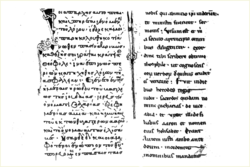- Minuscule 165
-
New Testament manuscripts
papyri • uncials • minuscules • lectionariesMinuscule 165
beginning of the Gospel of LukeName Codex Barberinianus 14 Text Gospels Date 1292 Script Greek-Latin Now at Vatican Library Size 30.4 cm by 20.4 cm Type Byzantine/mixed Category none Note marginalia Minuscule 165 (in the Gregory-Aland numbering), ε 1320 (Soden),[1] is a Greek-Latin minuscule manuscript of the New Testament, on parchment. It is dated by its colophon to the year 1292.[2] It has complex contents. It has marginalia.
Contents
Description
The codex contains a complete text of the four Gospels on 214 thick parchment leaves (size 30.4 cm by 20.4 cm).[2] The text is written in two columns per page, in 33 lines per page.[2]
The text is divided according to the κεφαλαια (chapters), whose numbers are given at the margin, and their τιτλοι (titles of chapters) at the top of the page (partly from later hand). There is also another division according to the smaller Ammonian Sections (in Mark 236 – 16:12), with references to the Eusebian Canons (written below Ammonian Section numbers).[3]
It contains the Epistula ad Carpianum, the Eusebian Canon tables at the beginning, tables of the κεφαλαια (tables of contents) before each Gospel, and synaxaria.[4]
Text
The Greek text of the codex is a representative of the Byzantine text-type. Hermann von Soden classified it to the textual family Kx.[5] Aland did not place it in any Category.[6]
According to the Claremont Profile Method it represents textual family Kx in Luke 10. In Luke 1 and Luke 20 it has mixture of the Byzantine text-families. It creates textual pair with Minuscule 176, related to the group 22.[5]
The Pericope Adulterae (John 7:53-8:11) is marked by an obelus.[3]
History
The manuscript was probably written in Calabria. The subscription states that it was written by Romanus for one Archbishop Paul, and given to the Library by Eugenia, daughter of John Pontanus († 1503).[4]
It was examined by Birch (about 1782), Scholz (1794-1852),[3] Victor Gardthausen.[7] C. R. Gregory saw it in 1886.[3]
It is currently housed at the Vatican Library (Barb. gr. 541), at Rome.[2]
See also
References
- ^ Gregory, Caspar René (1908). Die griechischen Handschriften des Neuen Testament. Leipzig: J. C. Hinrichs'sche Buchhandlung. p. 54. http://www.archive.org/stream/diegriechischen00greggoog#page/n65/mode/2up.
- ^ a b c d K. Aland, M. Welte, B. Köster, K. Junack, "Kurzgefasste Liste der griechischen Handschriften des Neues Testaments", Walter de Gruyter, Berlin, New York 1994, p. 56.
- ^ a b c d Gregory, Caspar René (1900). Textkritik des Neuen Testaments. 1. Leipzig: Hinrichs. p. 161. http://www.archive.org/stream/textkritikdesne00greggoog#page/n173/mode/2up.
- ^ a b Scrivener, Frederick Henry Ambrose; Edward Miller (1894). A Plain Introduction to the Criticism of the New Testament. 1 (4 ed.). London: George Bell & Sons. p. 215.
- ^ a b Wisse, Frederik (1982). The profile method for the classification and evaluation of manuscript evidence, as Applied to the Continuous Greek Text of the Gospel of Luke. Grand Rapids: William B. Eerdmans Publishing Company. p. 56. ISBN 0-8028-1918-4.
- ^ Aland, Kurt; Barbara Aland; Erroll F. Rhodes (trans.) (1995). The Text of the New Testament: An Introduction to the Critical Editions and to the Theory and Practice of Modern Textual Criticism. Grand Rapids: William B. Eerdmans Publishing Company. p. 138. ISBN 978-0-8028-4098-1.
- ^ V. Gardthausen, in Sitzungsbericht der phil.-hist. Classe der sächs. Gesellschaft der Wissenschaften 32 (Leipzig, 1880), pp. 73-78.
Further reading
- V. Gardthausen, in: Sitzungsbericht der Philosophisch-Historischen Classe der Sächsischen Gesellschaft der Wissenschaften 32 (Leipzig, 1880), pp. 73-78.
- Bruce M. Metzger, Manuscripts of Greek Bible: An Introduction to Greek Paleography, 1981, pp. 128-129.
External links
Categories:- Greek New Testament minuscules
- Vulgate manuscripts
- 13th-century biblical manuscripts
Wikimedia Foundation. 2010.

